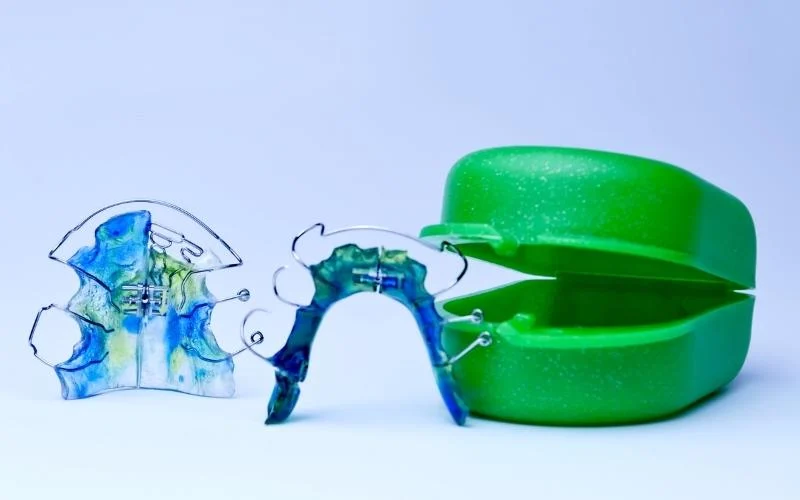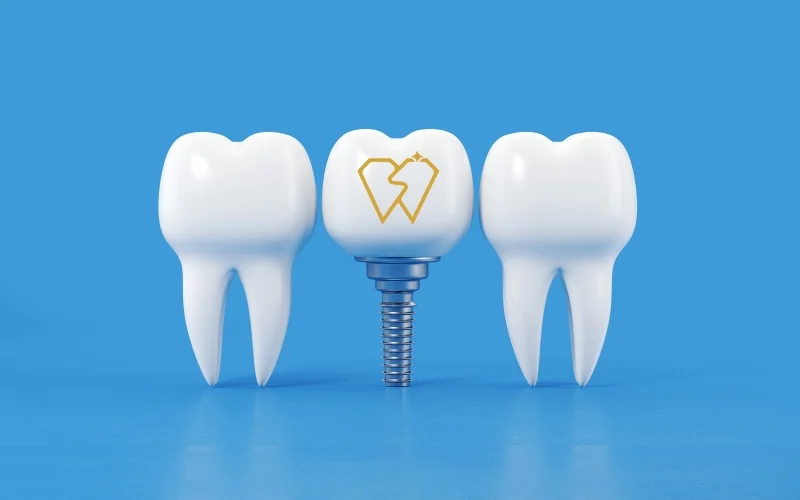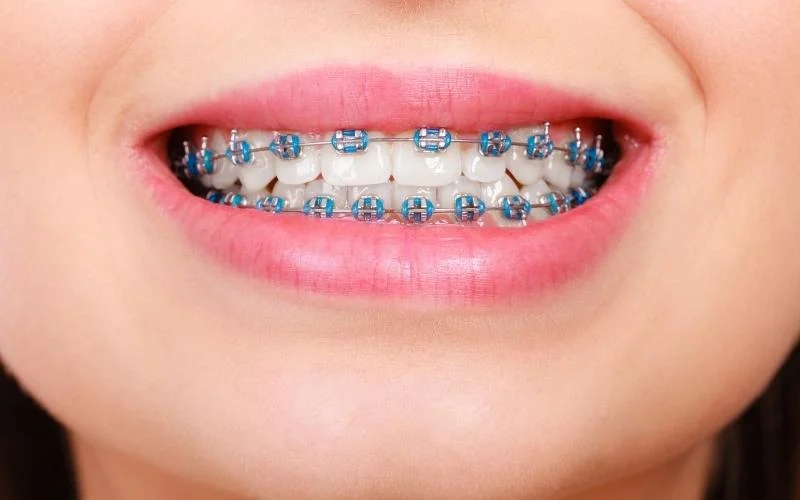What are teeth braces?
Braces are dental tools that help to treat teeth problems such as crowding, crookedness, and misalignment of the teeth.
As you wear braces, your teeth gradually straighten and align so that you have a normal bite. Some people get braces to make their smile look better.
Many general dentists perform basic tooth alignment and treat other tooth disorders, but orthodontists specialize in fixing severe dental issues. An orthodontist receives 2 to 3 years of advanced orthodontic training after dental school. They specialize in teeth straightening, incorrect bite correction, and jaw disorders. Your dentist or orthodontist will ask questions about your health, perform a clinical exam, digitally scan your teeth, photograph your teeth, and order X-rays of your mouth and head. Based on this information, they will devise a treatment plan.
How to know if you need braces?
The indications that an adult requires braces vary depending on age and oral health. Adult braces are becoming more popular, and the outcomes are generally positive.
The following symptoms may suggest that you need braces:
- Crowded teeth
- Difficulty flossing between crooked teeth
- Difficulty pronouncing certain sounds
- Jaws that make noises when you chew
- Stress on your jawline after chewing food
- Teeth that do not close appropriately over each other
- Difficulty flossing and brushing around teeth that frequently bite or cut your tongue
How do braces work?
Braces apply consistent pressure to the teeth and jaws to shift their position and alter the smile. The brackets connected to the teeth hold the archwire in place, putting pressure on the teeth. Teeth gradually shift into the desired position.
The soft tissue that covers the teeth and bone is called the periodontal ligament. These ligaments support teeth and can expand or contract in response to tooth movement.
The right ligament contracts when the braces move a tooth to the right side, and new bone develops on the left to fill in the space.
What is the right age to get teeth braces?
While braces can be used at any age, the best time to get braces is when the adult teeth have just come in, and the underlying dental structures have development potential.
The ideal timing for starting braces treatment is when a child has lost their primary teeth and developed most permanent adult teeth. This happens between the ages of 8 and 14. Most children aged 11 to 14 will be ready for braces by the middle school years.
Young braces patients (ages 9 to 15) should often expect faster outcomes and longer-lasting alignment than older patients. Because the teeth and bones are still growing, they are less thick, easier to move, and more likely to stay in their new positions permanently. Early adolescent children also have faster metabolisms, which helps with treatment even more.
Types of braces
Dental braces come in different types. Traditional metal braces, ceramic braces, lingual braces, and Invisalign/clear aligners are all dental braces that improve tooth alignment. Each type has its benefits and drawbacks that must be considered while deciding the best treatment option for each patient.
Metal Braces
Metal braces, also known as traditional braces, are the most prevalent type used worldwide and have been in use for over a century. Dentists attach braces to the teeth and connect them with a wire. The wire is attached to the braces via elastic ties, which come in various colors. At your checkups every 4-8 weeks, the orthodontist adjusts the wire to reposition the teeth.
Pros:
- Efficient and adjustable.
- No modifications to the speech.
- Colors are fun if you have appointments every 4-8 weeks.
- No waiting time.
- Least expensive.
Cons:
- Brushing and flossing are difficult.
- The most visible braces type aesthetically.
- Not recommended for those with poor dental hygiene.
Read more about metal (conventional) braces here.
Self-Ligating braces
Self-ligating braces resemble typical metal braces, but they use clips rather than elastic bands to keep the brace’s wire in place. As a result, there is less friction on the braces, and the individual usually finds it simpler to maintain the braces and teeth clean.
Pros:
- Easy to clean.
- Opening and closing self-ligating brackets during adjustment take much less time.
Cons:
- Pretty expensive.
- Need regular adjustment after installation.
Read more about self-ligating braces here.
Ceramic Braces
Ceramic braces are comparable in size and shape to regular metal braces, but they are made of a ceramic substance that blends with the natural color of the teeth, making the braces less obvious. This type is equally as efficient as regular braces at moving teeth into desirable positions, but it is far less obvious due to its color, making it a more appealing option for some people.
Pros:
- Produce better outcomes in less time than plastic aligners.
- Less visible than metal braces.
Cons:
- Their brackets may become stained with time.
- Cost more than metal braces.
- Need special attention to preserve hygiene and a clean appearance.
Clear Aligners (Invisalign)
Invisalign uses translucent plastic trays to shift teeth into place gradually. These templates are developed by computer simulation and are replaced every two weeks. Adults and teenagers with specific bite difficulties can benefit from the clear aligners system.
Pros:
- A discreet solution to straighten your teeth.
- The trays are also completely removable, so your diet, brushing, and flossing routine remain unchanged.
Cons:
- The trays are more expensive than standard braces.
- Invisalign can’t be used in severe dental conditions.
- Trays readily get misplaced and are costly to repair.
Read more about clear aligners here.
Lingual Braces
These are one of the types of invisible braces. These braces are attached to your teeth back, or lingual, side and are practically invisible.
Pros:
- Almost invisible
- Efficiently treat the majority of bite issues
- It can be adjusted to boost your comfort
Cons:
- May cost more than other types of braces
- Can cause a temporary lisp
- Take longer to put on than traditional braces
Myobraces
The Myobrace System is a preventive pre-orthodontic procedure that deals with the underlying causes of crooked teeth without needing a tooth extraction, allowing natural growth and development to occur.
Treatment is most suited for children aged 5 to 8. It entails wearing a series of removable intra-oral appliances for 1-2 hours each day and overnight while sleeping. Treatment might begin as early as three years old. The treatment helps with the following:
- Corrects bad oral habits, including mouth breathing, thumb sucking, and so on.
- Jaw development and alignment
- Enhances facial development
Myobraces do this by assisting the child to:
- Breathe in via the nose
- Rest the tongue at the proper resting position
- Correctly swallow
- Keep the lips together.
Pre-orthodontic treatment may benefit a patient if their problem can worsen over time if left untreated (e.g., crossbite).
The procedure of getting teeth braces
For some people, getting braces and maintaining them might be stressful. Knowing precisely what will happen and how to handle it is a great approach to ensure that you are prepared for your new braces. It is crucial to note that each individual will have a slightly different experience depending on their orthodontist and the precise treatment they receive.
Braces preparation
You must first consult with your orthodontist before receiving braces. Typically, the first visit consists of the following:
- Responding to questions about your dental and general health
- Conducting a clinical examination
- Obtaining X-rays
- Taking dental impressions of your teeth in preparation for braces
- Making a treatment plan
Your treatment plan will include the type of braces, what to expect, braces care tips, and an overall schedule.
The methodology
Because everyone’s mouth is unique, your braces experience will differ from that of your brother, sister, or friend. However, a standard method for getting traditional braces typically comprises your dentists performing the following.
- Teeth cleaning and drying
- Filling any tooth that has cavities
- Tooth extraction (some cases)
- Applying glue to the teeth to secure the brackets
- Putting the archwires in their brackets and securing them using elastic bands.
The operation should take about 1-2 hours. You should also expect discomfort because your tongue and cheeks will grind against the braces. It should take a week or so to get used to the sensitivity and pain.
How long do you need to wear the braces?
Generally, you have to wear braces for 12 to 36 months. The typical treatment duration is roughly 24 months, but this varies based on your unique condition and the type of treatment. More severe conditions need more time to treat, while mild ones require less time.
Other factors that influence the length of your treatment include:
- Your age
- Your natural metabolic rate
- Bone mineral density
- Grinding of the teeth (bruxism)
- Doctor’s experience and expertise
Children should expect to wear braces for a shorter time than adults since their teeth and bones are still growing, making it faster and easier to shift teeth into their ideal places. Adults have thicker, more established teeth and bones and a slower metabolism, so they typically wear braces for a more extended period.
Risks and complications of braces
Braces are extremely common and are generally regarded as minimal risk. However, difficulties might emerge, particularly if you do not maintain your dental hygiene routines while wearing braces. Here are five of the most common issues.
Demineralization of the enamel
Enamel demineralization happens when the enamel wears away from the tooth’s surface, which is frequently caused by sugar. If enamel demineralization is not controlled, it can lead to cavities and tooth decay, which will appear as stains on the teeth.
Gingivitis
Metal braces are more likely to cause gingivitis than transparent braces or removable orthodontic procedures like Invisalign. Because it causes the gum tissue to become red and sensitive, this condition can be unpleasant.
Also read: Swollen Gums: Symptoms, Causes, Treatments & Preventions
Teeth sensitivity
Sensitivity can occur in anyone, but it is more common in those who wear braces. Braces make it harder to maintain the gum line clean, which can contribute to gum recession.
Bad breath
When wearing braces, bad breath is a prevalent issue. This is owing to the multiple little areas that can serve as food traps.
Tartar
Tartar forms when plaque hardens on the surface of the teeth. Tartar deposits are easily discolored and frequently result in the growth of the other disease and, thus, more tartar.
Canker sores and soft tissue injuries
When you wear braces, your inner cheeks, lips, and gums may get irritated where the metal brackets and wires make contact. You may also develop canker sores where the sensitive internal mouth tissues brush against the metal components. If either of these problems emerges, your orthodontist can prescribe the appropriate treatment to alleviate discomfort and irritation while also healing the sensitive areas.
How to care for your teeth while wearing braces
Here is a guide on everything you must do to upkeep your braces.
Select the appropriate toothpaste, floss, and mouthwash
Your dentist will recommend the best mouthwash, floss, and toothpaste to eliminate bacteria that cause cavities, infections, and halitosis. Some oral health treatments contain abrasive ingredients that might corrode metal braces. Choose floss that is wide enough to fit between your teeth and along the bracket wires.
Brush your teeth to remove food particles.
Cleaning your teeth while wearing braces is different because you must be careful not to harm the metal wires or dislodge a bracket while removing all collected food particles. To protect your braces from damage, use a toothbrush with soft bristles.
Floss your teeth daily.
Purchase a floss recommended by your orthodontist and floss at least once each day. Flossing properly while having braces may help you avoid problems such as tooth decay and bad breath.
Use an oral irrigator.
An oral irrigator may assist you in removing excess microorganisms and food particles from your mouth. By releasing water from the water irrigator’s tank at a moderate pressure, a brush will dislodge food and bacteria from your teeth and braces. Based on your orthodontist’s instructions, you may only need to use an oral irrigator once a week for deep cleaning.
Choose your meals with care.
Your gums, teeth, and alveolar bones require a lot of nutrition while wearing braces. Consumption of healthy food is critical for toddlers and teens who are continually developing.
Here are some foods that you can eat while wearing braces.
- Mashed potatoes
- Pasta
- Meats that have no bones
- Soft vegetables
- Fruits
- Soups
- Dairy items
- Sandwiches and soft bread
Crunchy and sticky foods like nuts, bubble gum, and hard candies can cause brackets and wires to become loose, causing treatment to be delayed. Here is the list of foods to avoid when wearing braces.
- Nuts
- Popcorn
- Crunchy vegetables
- Hard candy (such as lollipops)
- Gum (Sugar-free gum is okay)
- Sticky candy (like gummy bears)
- Grilled corn on the cob
- Apples
- Jerky beef
- Pizza dough
In summary, excellent dental hygiene is critical while wearing braces. It can prevent stains, protect the health of your gums, and prevent foul odor. Dentists advise brushing your teeth after every meal whenever possible. If you can’t brush your teeth immediately away, gargling with water or mouthwash may help remove plaque, tartar, and food buildup.
What if your bracket or wire breaks?
Make an appointment with your orthodontist immediately if you detect any changes with the wire being loose, curved, or broken. It’s better to have it looked out than to wait weeks and discover that the wire has hampered your treatment.
Price of teeth braces in Malaysia
The cost of braces in Malaysia varies greatly but typically ranges from RM4,000 to RM25,000. Prices can vary depending on your location, dentist, and treatment type.
Click the link below to learn more about Stellar Dental’s latest teeth braces price.
Do braces hurt?
Braces do not hurt when attached to the teeth; therefore, there is no need to be concerned about the installation appointment. You may feel discomfort for a few days after the orthodontic wire is inserted into the freshly installed brackets. Your cheeks and lips may need a week or more to become used to having braces on your teeth.
Below is a video from one of our patient reviewing her experience getting braces treatment at Stellar Dental. You will see that she didn’t feel any pain throughtout her journey with us, at least.
Are there any alternatives to dental braces?
Some dentists recommend veneers or functional appliances as alternatives to dental braces. But the exact treatment choice depends upon your specific condition. Consult your dentist to learn more about the available options.
Conclusion
In conclusion, dental braces are a highly effective orthodontic treatment that can help straighten and align teeth to improve their appearance and function. If you are considering getting braces, visit our dental clinic near KL to learn more about the various types of braces and which option may be best for your individual needs. Our experienced team of dentists will be happy to answer any questions and help you achieve a beautiful, healthy smile. Contact us today to schedule the appointment and take the first step towards a straighter, healthier smile.








